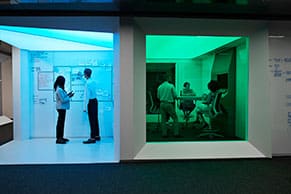No matter how many data points hotels follow to track their operations, their financials and their guests, their view will be incomplete if they don’t understand where they stand in relation to their competitors and the overall industry. Enter competitive benchmarking — a common business practice that helps hotels analyze and compare their progress toward goals against their industry peers. Once they have a clear idea of where they fit in, hoteliers are well-prepared to make a range of important, strategic decisions that help them get or remain ahead of the competition.
What Is Hotel Benchmarking?
Hotel benchmarking is the process of measuring and evaluating how well a property is performing compared to its competition, industry standards and the overall market. Comparisons typically take into account a variety of factors, such as financial metrics and guest satisfaction scores, to help a hotel understand where it is succeeding and where it needs improvement. Hoteliers can transform this data into actionable insights that drive strategic decision-making, set stronger performance goals, allocate resources in new ways, spot trends and implement improvements to help increase sales.
Key Takeaways
- Hotels use benchmarking to measure their performance against that of competitors.
- Benchmarking works best when a hotel measures its performance against properties that are similar in size, location, amenities and target audience.
- Strategies designed to address areas of improvement should be monitored and adjusted, based on evolving data and ongoing customer feedback.
- Revenue management systems, market intelligence platforms and direct-booking analytical programs can assist with benchmarking.
Hotel Benchmarking Explained
Travelers spend an average of five-plus hours researching online before booking a trip, comparing room rates, special packages, amenities and other offerings, according to Expedia and Luth Research. At the same time, hotels are hard at work attempting to woo travelers to click the “book” button. But are their efforts paying off? Tracking relevant performance data can, in part, help them answer that question. But it doesn’t tell the full story unless they also benchmark the results against competing hotels, industry standards and overall market conditions. To benchmark their progress against other brands, hoteliers first need to develop the right competitive set of hotels for comparison. These so-called “comp sets” typically consist of five to 10 hotels that are similar in terms of location, size, amenities, tier status and intended target audience.
Benchmarking categories include:
- Performance benchmarks, which compare how well a hotel is meeting its financial and operational goals and objectives in relation to others in its comp set. For example, a hotel might compare its revenue per available room (RevPAR) to the average RevPAR of similar properties in its market to gauge its relative performance and identify areas for improvement.
- Strategic benchmarks, which compare how well a hotel is achieving its long-term goals, such as growing market share, relative to its comp set, with the opportunity to potentially learn from the others in the set. For example, if a strategic goal is to increase guests’ average length of stay, hotel executives could study the ways better-performing hotels are achieving the goal.
- Process benchmarks, which compare operational efficiency on a more granular, workflow level. For example, do guests rate the check-in and checkout processes as fast and easy? Are maintenance issues addressed immediately?
Hotels can also assess their performance to their own prior performance. These internal benchmarks compare a hotel’s performance across different time periods and various departments within the company. For example, are occupancy rates lower or revenue higher this year compared to the previous year?
Benefits of Competitive Hotel Benchmarking
By regularly comparing their performance against industry standards and similar properties, hotels can unlock a wealth of benefits that can improve their operations, guest experience and bottom line. The following are eight key advantages of competitive benchmarking.
- Performance improvement: Benchmarking can identify areas where a hotel is outperforming or underperforming its competitors, providing a clear path for targeted improvements. Studying the best practices of top-performing properties can also lead to better results.
- Enhanced competitive edge: Understanding how a hotel stacks up against its comp set is crucial for staying ahead in the market or addressing shortcomings. It can also be a powerful way to motivate teams to work together toward a common goal.
- Operational efficiency: By comparing operational metrics (discussed later), hotels can identify inefficiencies and refine their processes. This can result in reduced costs, improved resource allocation and streamlined operations.
- Revenue optimization: Analyzing competitors’ pricing strategies, market segmentation and distribution channels are all ways that hotels can identify opportunities to increase their revenue and maximize profitability.
- Guest satisfaction and service quality: Comparing guest satisfaction scores and online reviews against those of competitors provides valuable insights into areas where a hotel can improve its service quality. By addressing common guest pain points, hotels can enhance the guest experience and build loyalty.
- Strategic planning and decision-making: Benchmarking data provides a foundation for long-term planning and informed decision-making, whether on a macro or micro level, such as making staffing decisions, expanding to a new location or setting environmental goals. Importantly, benchmarking also informs hotel budgeting and forecasting.
- Employee performance and morale: Benchmarking can also be used to evaluate and improve employee performance. By setting clear performance targets that are based on industry standards and by recognizing high-achieving staff members, hotels can boost employee morale and, in an industry with high turnover, improve retention.
- Market position and brand reputation: Consistent benchmarking allows hotels to evaluate their standing in the competitive landscape and gauge how guests perceive their brand. This information can guide branding and marketing strategies, helping hotels differentiate themselves to build a strong reputation.
Hotel Benchmarking Challenges
Yes, hotel benchmarking is a powerful tool for gauging performance and identifying areas for improvement, but it’s not without its hurdles. Here are six key challenges that can complicate the hotel benchmarking process.
- Data inaccuracy and inconsistency: The data used for benchmarking must be accurate, complete and consistently collected across equivalent time periods. Inconsistencies or errors in data can skew results, leading to flawed comparisons and misguided conclusions. For example, if one hotel includes resort fees when calculating how much revenue it earns per occupied room while another excludes them, the comparison becomes misleading.
- Comparability: Selecting an appropriate comp set is essential for making “apples to apples” comparisons. Hotels must consider factors, such as market segment, location, size, amenities and target audience, when selecting which competitors to benchmark against. Comparing a luxury resort to a limited-service airport hotel would yield little meaningful insight.
- Access to competitor data: Most hotels are reluctant to share proprietary data, which complicates the comparison process. Industry benchmarking services can help, but they may not provide the level of specificity a hotel needs to make valid comparisons.
- Dynamic market conditions: The hotel industry is constantly in flux, with new properties opening, others closing or rebranding, and market conditions fluctuating due to economic factors, travel trends and unforeseen events. This adds another wrinkle to a hotel’s ability to establish consistent benchmarks.
- Internal resistance: Some hotel staff may view benchmarking as an unnecessary task or even fear it will reveal their own performance shortcomings. Overcoming this resistance through solid change management requires demonstrating the value of benchmarking and cultivating a culture of continuous improvement. Framing it as a tool for learning and growth is key.
- Implementation challenges: Executing a successful benchmarking initiative requires significant time, resources and cross-functional coordination. Collecting and analyzing data, communicating findings and acting on insights involves multiple departments and can strain already busy staff. Lack of clear processes or accountability can derail implementation efforts.
Key Metrics for Hotel Benchmarking
By now it is likely clear that hotels use a slew of important key performance metrics (KPIs) to assess their progress, measured daily, annually and all points in between. Getting a better handle on a company’s financial situation can also ease accounting and the generation of financial statements. Key metrics used for hotel benchmarking include the following 12 KPIs.
1. Occupancy Rate
Occupancy rate measures the number of occupied hotel rooms as a percentage of the total number of rooms available at the property. In essence, it provides a snapshot of a hotel’s ability to attract guests. The formula to calculate occupancy rate is:
Occupancy rate = Occupied rooms / Available rooms x 100
If a hotel has 104 total available rooms and on a particular Tuesday it fills 51, then its occupancy rate is 49% (51 / 104 x 100). Seasonality, location, hotel type and other factors affect occupancy rate.
2. Average Daily Rate (ADR)
Hotel room rates can vary depending on how far in advance they are booked, the platform used to book the room and whether rewards points are used to pay for a guest’s stay. ADR is the average revenue earned for an occupied room on a particular night. Complimentary rooms — for example, those based on loyalty points — are not part of the ADR formula, which is:
Average daily rate = Total room revenue / Number of rooms sold
Let’s say a hotel with 275 available rooms sold 225 rooms on a particular night, generating $58,500 in total room revenue. Its ADR would be $260 ($58,500 / 225). As with all hotel properties, location and price go hand in hand, which is important to note for benchmarking purposes. A hotel located in a prime location, such as in a major city, can command a higher room rate and, therefore, have a higher ADR than one a train ride away.
3. Revenue Per Available Room (RevPAR)
RevPAR incorporates variables from ADR and occupancy rate to calculate the amount of money generated per room regardless of how many rooms are occupied. This metric provides a snapshot of a hotel’s overall performance. The formula to calculate RevPAR is:
RevPAR = Total room revenue / Total rooms available
Using the figures from the ADR example above, RevPAR would be $212.73 ($58,500 / 275).
4. Gross Operating Profit Per Available Room (GOPPAR)
Revenue from rooms sold typically represents a hotel’s largest source of revenue. But hotels have additional revenue sources, such as restaurant and spa purchases, as well as numerous expenses, such as for labor. Calculating GOPPAR helps a hotel understand how it’s managing costs and generating profits from all aspects of its operations.
Calculating GOPPAR begins with determining gross operating profit, which is the dollar amount left over after gross operating expenses are subtracted from gross operating revenue. Moving on, the formula to calculate GOPPAR is:
GOPPAR = Gross operating profit / Total available rooms
If a hotel has a gross operating profit of $300,000 and 1,200 available room nights, its GOPPAR is $250 ($300,000 / 1,200). Hotels often use GOPPAR to make decisions about setting room prices, controlling costs and allocating resources to maximize profits.
5. Market Penetration Index (MPI)
MPI allows a hotel to compare its occupancy rates relative to its comp set and the overall market. This information can help hoteliers make data-driven decisions to improve performance and gain market share. The formula to calculate MPI is:
Market penetration index = (Hotel occupancy rate / Market occupancy rate) x 100
If research shows that the market occupancy rate is 55% for the hotel with a 49% occupancy rate, its market penetration rate would be 89.1%. An MPI score of 100 or higher means a property is outperforming its competition, whereas a score of less than 100 suggests the property is underperforming.
6. Average Length of Stay (ALOS)
ALOS is the number of nights, on average, that a guest stays at a hotel. In general, a high ALOS translates into lower operational costs — and potentially higher profits— for example, by lightening the loads for housekeeping and front-desk services. For benchmarking purposes, it’s important to keep in mind that certain hotels, such as those near an airport, are bound to experience shorter stays than, for example, a property near an amusement park. The formula to calculate ALOS is:
Average length of stay = Total number of occupied room nights / Total number of reservations
If a hotel has 625 room nights booked as the result of 155 reservations for a one-week span, its average length of stay is four nights (625 / 155).
7. Cost Per Occupied Room (CPOR)
CPOR calculates how much it costs a hotel, on average, to operate a room for one night. Expenses usually include utilities, housekeeping, maintenance, cleaning supplies and internet services, all of which can cut into the property’s profits, if not properly managed. The formula to calculate CPOR is:
CPOR = Total operating expenses / Number of occupied rooms
If a hotel’s operating costs for a month were $100,000 for 500 occupied rooms, its CPOR would be $200 ($100,000 / 500).
8. Average Revenue Per Guest (ARPG)
Most hotels offer a range of room types, at various price points, to accommodate the needs of travelers who, for example, are traveling solo, with a spouse or with their families. As its name implies, ARPG measures the amount of revenue a hotel generates per guest during a specific time period. The formula to calculate ARPG is:
ARPG = Total room revenue / Total number of guests
If a hotel has 10 rooms occupied by 25 guests in total, and its room revenue is $2,000, its ARPG would be $80 ($2,000 / 25). This metric is helpful in assessing how the number of guests impacts overall revenue, and it is useful for guiding pricing and marketing strategies in the context of what competitors are doing.
9. Booking Lead Time
How far in advance a customer books a hotel stay provides managers with an expectation of occupancy levels during certain periods. For example, if a guest on June 30 reserves a room for July 18, the lead time would be 18 days. A longer lead time helps hotels better plan staff scheduling and inventory ordering, for example. Booking lead time can also play a role in room rates. For example, if a certain number of rooms aren’t booked prior to a certain arrival date, the hotel might decide to offer a last-minute discount to attract potential guests.
10. Customer Satisfaction Score (CSAT)
CSAT measures how satisfied guests are with their overall hotel experience, as well as specific aspects, like room cleanliness or staff friendliness. Data can be collected through post-stay surveys, where guests rate their satisfaction on a numeric scale. The hotel’s overall CSAT score is calculated as the percentage of respondents who gave a satisfactory rating.
11. Net Promoter Score (NPS)
NPS is a well-known KPI used by many industries to gauge customer satisfaction and loyalty. The survey asks one straightforward question: “On a scale of 0 to 10, how likely are you to recommend this business to a friend or colleague?” Based on their responses, respondents are categorized as either a Promoter (loyal and will recommend the business to others), a Passive (satisfied at the moment) or a Detractor (unhappy and will let others know). The formula to calculate NPS is:
NPS = Percentage of promoters – Percentage of detractors
Scores range from –100 (all Detractors) to +100 (all Promoters). The higher the NPS, the more satisfied a hotel’s customers are. In general, an NPS score above zero is considered good, while a score of 40 is considered excellent.
12. Employee Satisfaction and Turnover Rates
Turnover measures how many workers leave an organization voluntarily or by being terminated. For hotels, this so-called “separation rate” is among the highest of all industries tracked by the U.S. Bureau of Labor. High employee turnover in the hotel sector is partly attributed to low wages and limited benefits, combined with a demanding work environment. The formula to calculate employee turnover rate is:
Employee turnover rate = Number of employees who left / Average number of employees x 100
If, for example, a hotel with 350 employees loses 12 employees to attrition, its employee turnover rate would be 3.4% (12 / 350 x 100). Benchmarking will help reveal whether this rate is in line with that of competitors and the extent to which the hotel needs to address it.
Steps to Implementing Effective Hotel Benchmarking
With a clear strategy and modern benchmarking software in place, hotels can compare their performance to competitors and gain valuable insights into how to ramp up business. Hoteliers can follow the following step-by-step playbook for implementing hotel benchmarking.
1. Identify Benchmarking Partners
To be truly comparable, a hotel’s comp set should include peers that possess similar characteristics, including size, geographic location, target market and amenities. Other hotels for possible inclusion include those the hotel aspires to compete with and industry market leaders.
2. Collect and Analyze Data
Now it’s time for hotels to put KPIs to work, gathering their own metrics for internal benchmarking purposes, as well as to compare against their comp set and the industry at large. With the right software, data can be collected and analyzed in real time, allowing for more detailed performance insights and comparisons.
3. Develop Action Plans
With this newfound understanding, hotels can develop plans for improvement or optimization. For example, the hotel with erratic occupancy rates, as benchmarked against its own year-over-year rates, as well as its three biggest competitors, might decide to adjust its room rates or implement a targeted marketing campaign to boost sales during slow periods.
4. Monitor and Evaluate Progress
KPIs must be reviewed frequently, even daily, to gauge the effectiveness of improvement plans. Is revenue increasing? Did guests mention the hotel’s enhancements on customer satisfaction surveys? Hotels can leverage specialized benchmarking software to analyze KPIs in real time, comparing figures against historical data and industry standards.
5. Adjust Strategies
Benchmarking is an ongoing process, with new data becoming available constantly that can shape or reshape a company’s strategies. For instance, if benchmarking data reveals that a hotel has fewer business travelers compared to its comp set, management might step up its marketing strategies with special offers targeted to corporate clients to increase bookings.
6. Foster a Culture of Benchmarking
Hoteliers should be transparent about the company’s strategies, goals and reasons for implementing changes. Doing so can help keep staff motivated and engaged and foster a culture where new ideas are welcome. In addition, it’s a good idea to keep employees apprised of the hotel’s competitive performance and even tie incentives or rewards to improvements that help close in on or pass competitors. The goal is to create an environment where benchmarking becomes second nature, leading to a culture of continued learning and innovation.
Improve Your Benchmarking With NetSuite for Hospitality
Determining where a hotel stands in the market in relation to its competitors requires the collection and analysis of reams of data — a complicated task made simple with the right software. NetSuite for Restaurants and Hospitality meets the hotel industry’s changing business needs with advanced analytics capabilities that provide real-time visibility into financial, operational, and supply chain metrics. The unified, cloud-based platform also features point-of-sale integration, a guest service dashboard that manages and resolves customer inquiries and complaints, franchise management and more. Among its benefits, NetSuite helps hotels streamline their operations, increase profitability and enhance the customer experience.
No hotel exists in a bubble. Competitive benchmarking helps hotels understand where they stand and how they’re faring against competing properties — highlighting strengths, weaknesses and even best practices to borrow. By collecting valuable data about occupancy rates, revenue generation and guest satisfaction, to name a few KPIs, hotels can strengthen their pricing strategies, implement operational efficiencies, control costs and identify other opportunities that improve their ability to compete in the market.
#1 Cloud ERP
Software
Hotel Benchmarking FAQs
What is benchmarking in the hotel industry?
Hotel benchmarking gauges performance in comparison with other similar hotels and with industry standards. Hotels might even benchmark themselves after others they hope to emulate in the future.
What is a hotel benchmark rate?
A hotel benchmark is any metric used to compare the performance of one hotel to another. Three common metrics, or key performance indicators, are occupancy rate, average daily rate and revenue per available room.
What are the benefits of benchmarking in hotels?
Hotel benchmarking can improve a hotel’s performance in a variety of areas, including revenue growth, operational efficiency, guest satisfaction and brand reputation. Benchmarking helps properties determine pricing strategies, monitor areas of excellence and target areas to improve.
What is a benchmark in tourism?
Also referred to as destination benchmarking, tourism benchmarking compares the performance, characteristics and practices of one tourism destination to that of similar destinations. Tourism benchmarks can include infrastructure in a particular area, such as an airport or train station, quality standards, excursion possibilities, things to do and more.
What are two ways that benchmarking could be useful to a hotel chain?
Benchmarking identifies performance gaps between a particular hotel and comparable hotels in the market. That, in turn, provides a blueprint for ways to improve, which can lead to increased occupancy, revenue, brand recognition and guest satisfaction. Knowing how similar hotels are performing gives a hotel the opportunity to develop strategies to attract more business and develop a competitive advantage.
Why is benchmarking important in the hospitality industry?
Any opportunity to elevate hotel performance across multiple categories leads to a greater level of customer satisfaction. Happy customers build stronger customer loyalty and a deeper sense of brand recognition and awareness, which can lead to increased revenue.
What is a benchmarking standard?
A benchmarking standard is a reference point of data against which a hotel measures and compares its performance and also sets goals. In the hotel industry, for example, that could mean tracking a property’s average length of stay (ALOS). For example, over the course of six months, if the ALOS is three days, the hotel could target four or five days as a goal and develop strategies to drive more business.









